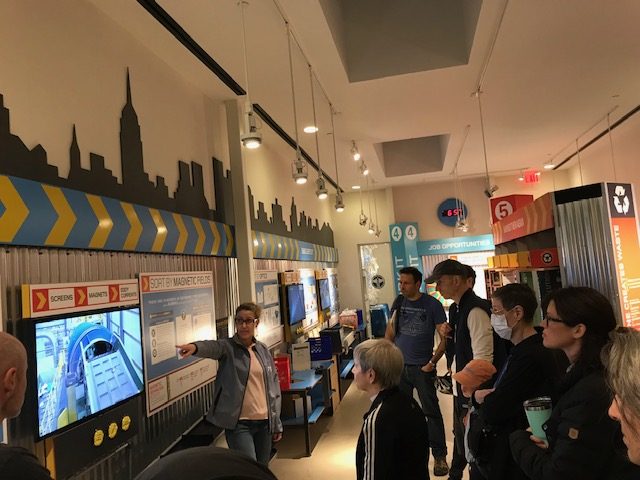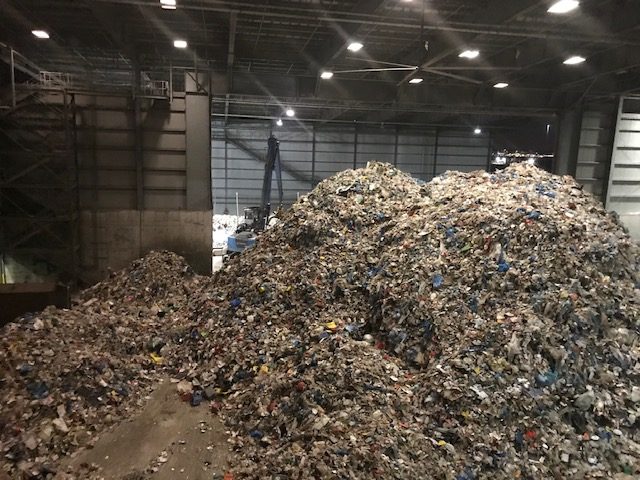GreenHomeNYC Tour of SIMS Recycling Center
December 29, 2019
By Gahl S. Spanier
Once you’ve gotten use out of an item and decide to recycle it, you might conclude that it has become worthless. In fact, the opposite is true; when you recycle an item in NYC, it will participate in a vast economy of disposal and repurposing. The NYC Department of Sanitation brings most of it to the SIMS recycling center, a facility operating under a private-public partnership between the SIMS corporation and NYC. The partnership involves a pricing scheme in which the city pays SIMS a nominal recycling fee for every bale absorbed by the facility, but this price drops or may even reverse into a payment to the city based on the revenue SIMS gets, converting the recyclables into useful raw materials.
The GreenHomeNYC Sustainability Tour Team organized a visit to the SIMS Recycling Center on Monday, October 14th, which was expertly guided by Kara Napolitano. Her avid enthusiasm about recycling and excellent demonstration props on premises made the complex processes ongoing in the facility simple and legible to the visitors. Our diverse attendee group, ranging in age from five to 75, was very curious about some of the intricate but impactful aspects of recycling. Should you keep the lid on the plastic bottle? Yes. Should you keep the beverage carton lid on? Yes, but remember to put the carton and lid in the plastics and not the paper stream. Should you keep on the metal lid of a glass jar? No. What actually happens to an item once it leaves your recycling bin? And so on. These rules and more, which you can find here, stem from the specific sorting and processing methodologies used at the SIMS facility – starting with getting the recycling out of the bags. It’s harder than you might think, at a daily volume of 1,000 tons. Glass crushers and sieves separate the glass out, weight and magnet conveyors get the metal sorted out, then sub-sort ferrous and aluminum, while the plastic passes through 16 state-of-the-art optical sorters, identifying high-value plastic types and sorting them incredible rates of several tons/hour. Our group was also eager to hear about trends in waste processing, even beyond the specific streams coming to the SIMS facility, including composting and toxicity issues with landfill and incineration. We learned that beyond the state-of-the-art process engineering we observed in the facility itself, waste management is all about big data analysis, economic market development, equity, and motivating people to do the right thing at every stage of the recycling loop. That macro-scale recycling loop consists of consumers buying a product with a recyclable component, getting this component into a bin, getting the bin content collected and freighted at the urban scale to the recycling facility, sorting and separating the materials with commercial value and selling them to manufacturers who will use them in their products. The loop ultimately depends on consumers’ choosing products with recycled components, so these products can economically compete with those made from raw materials. While we should certainly urge ourselves and everyone around us to make recycling a high priority, we learned that in NYC only about 50% of recyclables get recycled. We also noted that plastics, a big portion of our recycling stream, can only be recycled 1-8 times before they become useless waste, and every recycling loop consumes resources in the form of human labor, energy, and water. Consequently, we should prioritize reducing our consumption and reusing what we have before we resort to recycling.
While we should certainly urge ourselves and everyone around us to make recycling a high priority, we learned that in NYC only about 50% of recyclables get recycled. We also noted that plastics, a big portion of our recycling stream, can only be recycled 1-8 times before they become useless waste, and every recycling loop consumes resources in the form of human labor, energy, and water. Consequently, we should prioritize reducing our consumption and reusing what we have before we resort to recycling.



